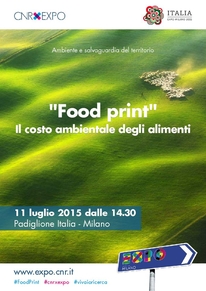“Food-print”: The environmental cost of food

Coordinator: Pierpaolo Duce
Institute of Biometeorology (IBIMET)
Interview to Pierpaolo Duce
What kind of event will be organized at EXPO?
It is a half day conference designed to be engaging in a highly informative format and open to the public, with the aim of exchanging views among and with experts and collecting information on Food-print.
Is there a relationship between the quality of foods and their environmental impact?
In general, it is expected that the following equation is valid: lower impact, better organoleptic properties. In other words, the lower the environmental impact the better the quality of food, on average.
In the future will we have food products with labels that clearly indicate their environmental impact?
The path is clearly traced, and other sectors have already begun. Think about the auto industry: now all car manufacturers indicate the CO2 emissions of their vehicles. This is due to legislative pressure, but also because more and more consumers pay attention to environmental issues. The same applies even more for the agri-food sector. Also in this case, consumers focus not only on the sensory characteristics of food, but also on the environmental quality and on the greater or lesser impact that food products may have. There is also a more stringent pressure from the EU guidelines and regulations: for example, the new Common Agricultural Policy (CAP) encourages farmers to use more environmentally-friendly farming methods and increase the environmental performance of the production systems, contributing to reduce pollution and greenhouse gas emissions into the atmosphere. Some agri-food producers and products such as cheese, milk, oil, wine, pasta and other cereal products have already taken this path, through voluntary certification schemes. They are driven by the need to comply with EU regulations and also to satisfy the changing and environmentally-oriented customers’ needs.
What is the EU doing to reduce impacts?
The new CAP 2014-2020 complies with the Europe 2020 strategy. One of the key points is to move towards agriculture systems that reconcile their economic and ecological functions, reducing carbon emissions and using resources more efficiently. This backbone will also be accompanied by financial incentives for farmers who stand in line with EU policies.
How can you calculate the environmental impact of foods
The Life Cycle Assessment approach consists in estimating the environmental effects of a product or process “from cradle to grave”. Some productive processes cause greenhouse gas (GHG) emissions directly, other processes determine indirect emissions: all emissions can be expressed in CO2 equivalents. Let’s make an example. To produce milk, most dairy farmers use milking machines, which need water and power. These consumptions are then converted into equivalent CO2 amounts. In addition, the milking machine must first be constructed and, therefore, a fraction of the emissions due to the construction of the equipment will contribute to the environmental cost of 1 liter of milk or 1 kg of cheese.
In other words, you need to account not only for the actual emissions from fuel used for farm machinery, but also for the indirect emissions. In the livestock sector, for example, significant GHG emissions arise from enteric fermentation by ruminants and manure, which is one of the main sources of emissions. Of course, these types of emissions are included in the calculation of the overall emissions. Note that methane emitted by manure has a potency, or global warming potential, of about 25 times that of CO2. Although it is clear that GHG emissions vary largely with the type of production activity.
What aspect of livestock has the greatest impact on the environment?
In the livestock sector – which will be the primary focus of the Food-print EXPO event – beyond the impact on climate change determined by the enteric and manure emissions, almost half of the impact depends on the production and processing of animal feed. Wider adoption of existing best practices and technologies in feeding, health and husbandry, and manure management could help the global livestock sector cut its outputs of global warming gases as much as 30 percent.








